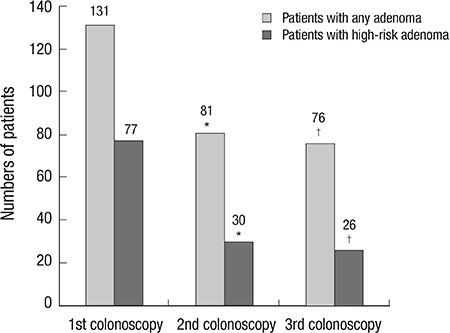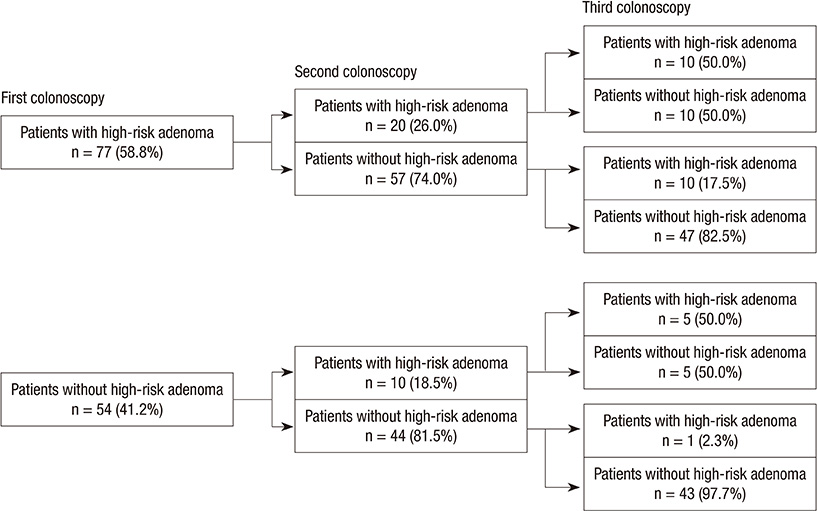J Korean Med Sci.
2013 Sep;28(9):1345-1350. 10.3346/jkms.2013.28.9.1345.
Factors Predictive of High-Risk Adenomas at the Third Colonoscopy after Initial Adenoma Removal
- Affiliations
-
- 1Department of Internal Medicine and Institute of Gastroenterology, Yonsei University College of Medicine, Seoul, Korea. sjpark@yuhs.ac
- 2Department of Internal Medicine and Institute of Gastroenterology, Ajou University College of Medicine, Suwon, Korea.
- KMID: 1793051
- DOI: http://doi.org/10.3346/jkms.2013.28.9.1345
Abstract
- Evaluating predictive factors for high-risk adenomas at the third colonoscopy based on two prior colonoscopies may help evaluate high-risk adenoma at the third colonoscopy. We analyzed clinical data of 131 patients at Severance Hospital from January 1997 to January 2011. All of them underwent two subsequent colonoscopies after removal of adenomas during an initial colonoscopy. Among 20 patients with high-risk adenoma at the first and second colonoscopies, 10 (50%) patients had high-risk adenoma at the third colonoscopy. Among the 67 patients who had high-risk adenoma only once at the first or second colonoscopy, 15 (22.4%) patients had high-risk adenoma at the third colonoscopy but among the 44 patients without high-risk adenoma at the first and second colonoscopies, only 1 (2.3%) patient had high-risk adenoma at the third colonoscopy (P < 0.001). A multivariate time dependent covariate Cox regression analysis confirmed that high-risk adenoma at the first and/or second colonoscopy (HR, 9.56; 95% CI, 2.37-38.54; P = 0.002) was independent predictor of high-risk adenoma at the third colonoscopy. Given these findings, data from two prior colonoscopies, not one prior examination, may help identify high-risk populations at the third colonoscopy who require careful colonoscopic surveillance.
MeSH Terms
Figure
Cited by 1 articles
-
Comparison of the Efficacy and Safety of Sodium Phosphate Tablets and Polyethylene Glycol Solution for Bowel Cleansing in Healthy Korean Adults
Seung-Hwa Lee, Duck-Joo Lee, Kwang-Min Kim, Sang-Wook Seo, Joon-Koo Kang, Eun-Hye Lee, Dong-Ryul Lee
Yonsei Med J. 2014;55(6):1542-1555. doi: 10.3349/ymj.2014.55.6.1542.
Reference
-
1. Fukutomi Y, Moriwaki H, Nagase S, Tajika M, Naito T, Miwa Y, Yamada Y, Araki H, Okuno M, Nagura K, et al. Metachronous colon tumors: risk factors and rationale for the surveillance colonoscopy after initial polypectomy. J Cancer Res Clin Oncol. 2002; 128:569–574.2. Yood MU, Oliveria S, Boyer JG, Wells K, Stang P, Johnson CC. Colon polyp recurrence in a managed care population. Arch Intern Med. 2003; 163:422–426.3. Neugut AI, Jacobson JS, Ahsan H, Santos J, Garbowski GC, Forde KA, Treat MR, Waye J. Incidence and recurrence rates of colorectal adenomas: a prospective study. Gastroenterology. 1995; 108:402–408.4. Atkin WS, Saunders BP. British Society for Gastroenterology. Association of Coloproctology for Great Britain and Ireland. Surveillance guidelines after removal of colorectal adenomatous polyps. Gut. 2002; 51:V6–V9.5. Davila RE, Rajan E, Baron TH, Adler DG, Egan JV, Faigel DO, Gan SI, Hirota WK, Leighton JA, Lichtenstein D, et al. ASGE guideline: colorectal cancer screening and surveillance. Gastrointest Endosc. 2006; 63:546–557.6. Winawer SJ, Zauber AG, Fletcher RH, Stillman JS, O'brien MJ, Levin B, Smith RA, Lieberman DA, Burt RW, Levin TR, et al. Guidelines for colonoscopy surveillance after polypectomy: a consensus update by the US Multi-Society Task Force on Colorectal Cancer and the American Cancer Society. CA Cancer J Clin. 2006; 56:143–159.7. Hamilton SR, Aaltonen LA. World Health Organization classification of tumours: pathology and genetics of tumours of the digestive system. Lyon: IARC Press;2000.8. Saito Y, Uraoka T, Yamaguchi Y, Hotta K, Sakamoto N, Ikematsu H, Fukuzawa M, Kobayashi N, Nasu J, Michida T, et al. A prospective, multicenter study of 1111 colorectal endoscopic submucosal dissections (with video). Gastrointest Endosc. 2010; 72:1217–1225.9. Tanaka S, Oka S, Chayama K. Colorectal endoscopic submucosal dissection: present status and future perspective, including its differentiation from endoscopic mucosal resection. J Gastroenterol. 2008; 43:641–651.10. Robertson DJ, Burke CA, Welch HG, Haile RW, Sandler RS, Greenberg ER, Ahnen DJ, Bresalier RS, Rothstein RI, Cole B, et al. Using the results of a baseline and a surveillance colonoscopy to predict recurrent adenomas with high-risk characteristics. Ann Intern Med. 2009; 151:103–109.11. Blumberg D, Opelka FG, Hicks TC, Timmcke AE, Beck DE. Significance of a normal surveillance colonoscopy in patients with a history of adenomatous polyps. Dis Colon Rectum. 2000; 43:1084–1091.12. Bertario L, Russo A, Sala P, Pizzetti P, Ballardini G, Andreola S, Spinelli P. Predictors of metachronous colorectal neoplasms in sporadic adenoma patients. Int J Cancer. 2003; 105:82–87.13. Noshirwani KC, van Stolk RU, Rybicki LA, Beck GJ. Adenoma size and number are predictive of adenoma recurrence: implications for surveillance colonoscopy. Gastrointest Endosc. 2000; 51:433–437.14. Martínez ME, Sampliner R, Marshall JR, Bhattacharyya AK, Reid ME, Alberts DS. Adenoma characteristics as risk factors for recurrence of advanced adenomas. Gastroenterology. 2001; 120:1077–1083.15. Lorenzo-Zúñiga V, Moreno de Vega V, Domènech E, Mañosa M, Cabré E, Planas R, Boix J. High-definition colonoscopy and risk factors for recurrence of advanced adenomas in patients with a personal history of polyps. Eur J Gastroenterol Hepatol. 2011; 23:425–430.16. Lieberman DA, Weiss DG, Harford WV, Ahnen DJ, Provenzale D, Sontag SJ, Schnell TG, Chejfec G, Campbell DR, Kidao J, et al. Five-year colon surveillance after screening colonoscopy. Gastroenterology. 2007; 133:1077–1085.17. Nusko G, Hahn EG, Mansmann U. Characteristics of metachronous colorectal adenomas found during long-term follow-up: analysis of four subsequent generations of adenoma recurrence. Scand J Gastroenterol. 2009; 44:736–744.18. Jørgensen OD, Kronborg O, Fenger C, Rasmussen M. Influence of long-term colonoscopic surveillance on incidence of colorectal cancer and death from the disease in patients with precursors (adenomas). Acta Oncol. 2007; 46:355–360.19. Moon CM, Cheon JH, Choi EH, Kim ES, Park JJ, Han SY, Kim DH, Kim TI, Kim WH. Advanced synchronous adenoma but not simple adenoma predicts the future development of metachronous neoplasia in patients with resected colorectal cancer. J Clin Gastroenterol. 2010; 44:495–501.20. Külling D, Christ AD, Karaaslan N, Fried M, Bauerfeind P. The presence of more than two index adenomas is the strongest predictor of metachronous colon adenomas. Swiss Med Wkly. 2002; 132:139–142.21. Winawer SJ, Zauber AG, O'Brien MJ, Ho MN, Gottlieb L, Sternberg SS, Waye JD, Bond J, Schapiro M, Stewart ET, et al. Randomized comparison of surveillance intervals after colonoscopic removal of newly diagnosed adenomatous polyps: the National Polyp Study Workgroup. N Engl J Med. 1993; 328:901–906.22. Triantafyllou K, Papatheodoridis GV, Paspatis GA, Vasilakaki TH, Elemenoglou I, Karamanolis DG. Predictors of the early development of advanced metachronous colon adenomas. Hepatogastroenterology. 1997; 44:533–538.
- Full Text Links
- Actions
-
Cited
- CITED
-
- Close
- Share
- Similar articles
-
- Risk Factors for Recurrent High-Risk Polyps after the Removal of High-Risk Polyps at Initial Colonoscopy
- Importance of Early Follow-up Colonoscopy in Patients at High Risk for Colorectal Polyps
- Advanced Colonic Neoplasia at Follow-up Colonoscopy According to Risk Components and Adenoma Location at Index Colonoscopy: A Retrospective Study of 1,974 Asymptomatic Koreans
- Pattern of Adenomas after Colorectal Cancer Surgery
- Optimal Colonoscopy Surveillance Interval after Polypectomy



